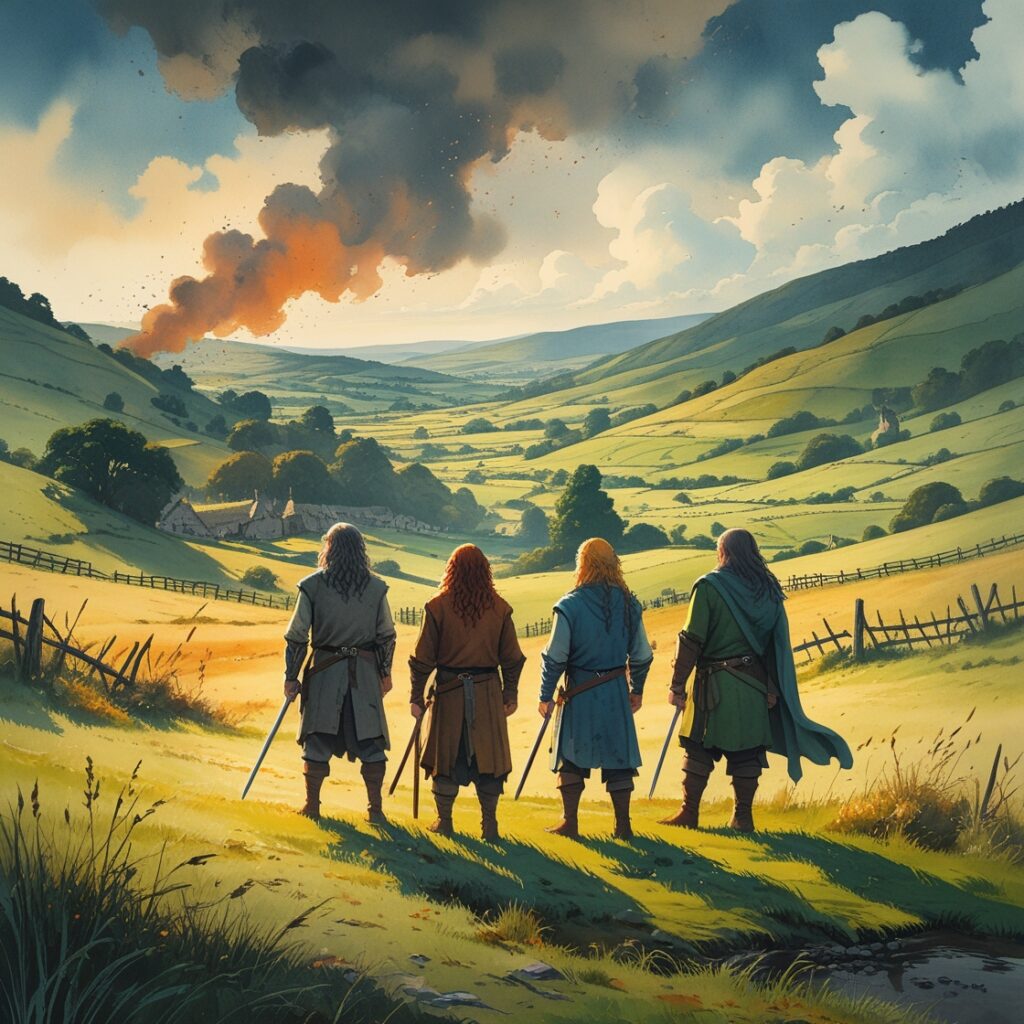A few days ago I found myself obsessively Googling phrases like “Return of the King book vs. movie ending”, “Scouring of the Shire explained”, “Why wasn’t the Scouring of the Shire in the movie?” and a hundred other search terms, only to come up short on clear answers. If you’ve also typed in “Lord of the Rings final confrontation left out” “Differences between The Lord of the Rings book and movie endings”, or even “LOTR The Return of the King missing scenes” you know how frustrating it is sifting through random forum debates without a definitive explanation.
I decided enough was enough. I had to write an article that fully lays out—for the average person—how the final book in Tolkien’s trilogy actually ends and why The Scouring of the Shire got the boot in the Peter Jackson film adaptation. But before we dive in, here’s a major spoiler warning: if you haven’t watched The Return of the King or read the book (or both!), stop reading now. Trust me, you don’t want this crucial piece of hobbit history ruined for you.
Still here? Good. In this article, I’ll clarify the lesser-known differences between the movie’s triumphant conclusion and the more complex ending of Tolkien’s text—especially the part about Saruman and his post-war mischief in the heart of the Shire. Consider this your one-stop resource for understanding the final conflict that Peter Jackson decided not to include, what exactly The Scouring of the Shire means for our beloved hobbits, and how it affects the emotional resonance of Tolkien’s masterpiece. By the end, you’ll see why this missing chapter is absolutely pivotal, and why its omission shapes our entire view of the war’s aftermath. Let’s delve into a side of Middle-earth’s final act that most filmgoers never knew existed.
The Homeward Road and the Shadows Unseen
Contrary to the film’s portrayal, which culminates the final trial on Mount Doom, Tolkien’s original narrative reveals that Frodo, Sam, Merry, and Pippin face an additional, unforeseen ordeal upon their return to the Shire (their home land). In the book, their homecoming is met with devastation: fields are ravaged, ancient hedgerows are dismantled, and the cherished Party Tree is reduced to a lifeless stump. Saruman, who in the movie meets his end atop Orthanc, survives to make his final stand within the Shire, embedding himself in Bag End as a minor despot.
This unexpected development is frequently perceived by casual readers as a detached adventure, echoing the very war the hobbits endeavored to conclude. Indeed, many find this subsequent confrontation disorienting—having traversed numerous pages or hours of film only to encounter another conflict. Nevertheless, Tolkien deemed it indispensable. In the foreword to the second edition of The Lord of the Rings, he asserts that the Scouring was “an essential part of the plot, foreseen from the outset.” This chapter completes a comprehensive narrative arc: no region of Middle-earth, no matter how serene or secluded, remains entirely unscathed by the pervasive influence of evil.
The Scouring of the Shire
In Peter Jackson’s cinematic rendition, Saruman’s storyline concludes away from the pastoral tranquility of Hobbiton. Conversely, the book reveals that the Shire becomes the stage for Saruman’s final act of manipulation. Devoid of magical prowess, Saruman resorts to the power of his rhetoric and the allegiance of a motley crew of ruffians. These antagonists impose oppressive rules and corrupt the Shire’s idyllic environment with cruelty and fear. However, Frodo, Sam, Merry, and Pippin return not as innocent hobbits but as battle-hardened veterans. Merry wields the horn of Rohan, Pippin brings experience from his service in Gondor, Sam remains steadfast, and Frodo embodies quiet resilience. Together, they ignite a rebellion, culminating in the Battle of Bywater—the first armed conflict in the Shire in centuries.
For many readers, this chapter exudes a darker tone than the preceding war, eschewing fantastical creatures like orcs and trolls in favor of human antagonists who subjugate hobbits within their own lands. This shift underscores how warfare can corrupt even the most peaceful regions. Modern commentators have observed that The Return of the King transitions from grand heroic narratives to more intimate and unsettling themes. Here, the protagonists are not only defending Middle-earth at large but are also reclaiming their personal sanctuaries from the clutches of greed and malevolence.
The Price of Return
Similar to the film’s bittersweet departure at the Grey Havens, the book delves deeper into the restoration of the Shire and the personal toll on Frodo. While Sam’s unwavering dedication, aided by Galadriel’s gift, restores the Shire to its former glory, Frodo remains spiritually scarred by the immense burden he carried. His inability to fully reintegrate into hobbit society stems from the profound impact of the Ring’s malevolence, leaving wounds that transcend physical injuries. Consequently, Frodo chooses to depart for the Undying Lands with Gandalf and Bilbo, entrusting the final moments and joys to his loyal friend Samwise.
Critics argue that this additional conflict extends an already extensive narrative. Indeed, the movie’s multiple endings are renowned in their own right, and Peter Jackson himself acknowledged that introducing another quest at such a late stage might appear “anticlimactic.” However, Tolkien viewed the Scouring as a critical exposition of a fundamental truth: the insidious reach of evil can infiltrate even the most tranquil and secluded areas. Victory on a grand scale does not inherently ensure safety at one’s doorstep. This segment illustrates that the hobbits must demonstrate their growth and resilience within their own domain, and that the remnants of conflict leave indelible marks on both the world and its heroes.
A Lost Epilogue: Sam, Rosie, and the Children
In the initial drafts, Tolkien contemplated an epilogue portraying Sam’s later years—narrating tales to his daughter, Elanor, and recounting the ultimate fates of his dear friends. This envisioned conclusion would have culminated in a serene scene with Sam and Rosie by the hearth, reflecting on the perilous days when Frodo destroyed the Ring and the Shire remained oblivious to the true cost of their victory. Tolkien ultimately excised this epilogue, concerned that multiple endings might exhaust the reader, a decision he later regretted. This omitted section serves as a poignant reminder that life in the Shire persevered, enriched by Sam’s unwavering devotion and the hard-earned peace that followed.
Why This Change Matters
In Jackson’s film adaptation, the Shire remains untouched by war, allowing Sam, Merry, and Pippin to reintegrate seamlessly into its embrace. However, the book presents a starkly different reality: the four hobbits return as heroes to a Shire marred by conflict, necessitating their leadership to overthrow Saruman’s oppressive rule. This final trial serves as a testament to their transformation from simple, unassuming hobbits into courageous leaders. It also emphasizes that Frodo’s psychological scars are not mere remnants of a distant journey but are exacerbated by witnessing the devastation of his beloved homeland. His ultimate decision to seek the Undying Lands gains profound significance, illustrating that even the familiarity of home cannot provide the complete healing he seeks.
While Peter Jackson’s films have solidified their status as modern classics, introducing myriad new enthusiasts to the splendors of Middle-earth, the exclusion of the Scouring undeniably alters the narrative’s concluding harmony. Without this chapter, the story concludes on a more triumphant and unblemished note for the Shire, neatly encapsulating the “happily ever after” trope. Conversely, for those immersed in Tolkien’s literature, the final battle in the Shire delivers an essential message: even the most diminutive and gentle beings must occasionally defend their homes, and despite achieving victory, both the world and its heroes remain irrevocably changed.
Link to our Short Book Summary
A concise account of Lord of the Rings: The Return of the King book
To conclude, this article has delineated the significant disparities between the endings of J.R.R. Tolkien’s The Lord of the Rings: The Return of the King book and Peter Jackson’s cinematic adaptation. By omitting “The Scouring of the Shire,” the film forgoes a crucial examination of the hobbits’ personal growth and the pervasive impact of evil on even the most serene locales of Middle-earth. This exclusion not only simplifies the narrative’s resolution but also diminishes the profound message Tolkien intended regarding the enduring consequences of war and the necessity of safeguarding one’s homeland. For enthusiasts seeking a deeper understanding of the story’s full scope, engaging with the original text is indispensable. Ultimately, recognizing these differences enhances our appreciation of both the literary and filmic renditions, highlighting the intricate layers that define Tolkien’s masterpiece.

